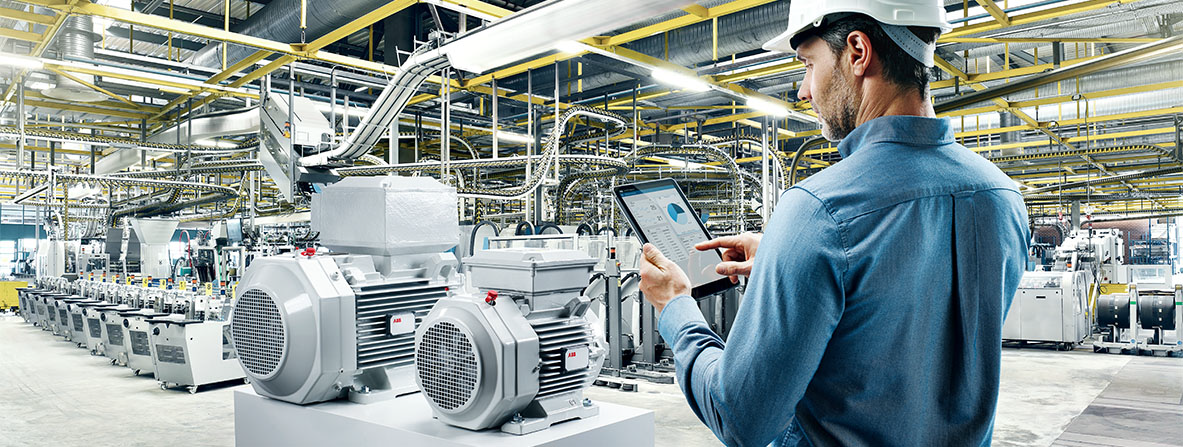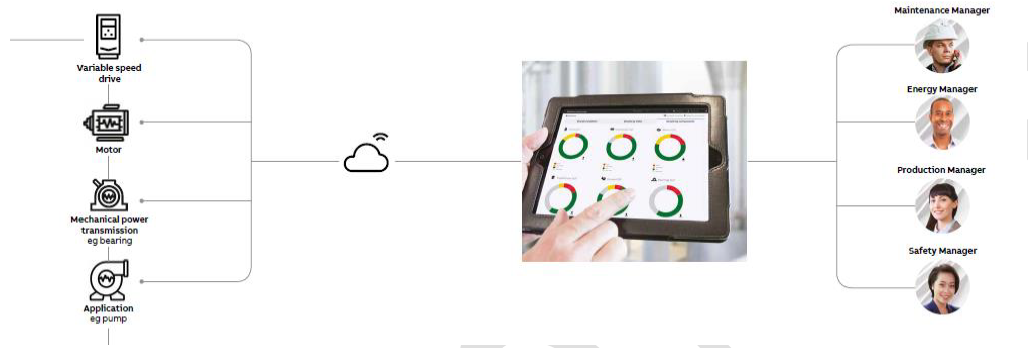Pumps go digital to boost resilience
Steve Hughes, ABB’s digital lead for its motion business, discusses how digitalisation is changing the face of the pump powertrain.
Pumps are a vital part of processes in many industries, not least the water and wastewater sector. In this industry, the health and wellbeing of a water utility’s customers are at stake and as such, pump failures can prove very costly.
Pumps often work in harsh and challenging conditions and to prevent failure, caused through events such as clogging of the impellers, they must be checked regularly, which can be costly and time-consuming.
Connecting the powertrain
Yet, pumps themselves are only one part of a powertrain, the individual components of which work together to move the fluids in the application. A powertrain can comprise the motor driving the pump, a variable speed drive (VSD) that controls the motor’s speed to achieve the optimum pumping rate and, sometimes, mounted bearings and gearing.
Should a pump set stop operating, then the practice could be for the on-site maintenance team to summon support from the OEM that supplied the pump. However, if the pump has stopped working because the VSD has tripped then this could lead to further delay as the OEM contacts the drive supplier for advice. If a call out is required, then the time delays and cost implications become much greater.
Smart sensor technology
But all this is set to change as digital technology is applied to each part of the powertrain. The biggest change is the arrival of a small device called a smart sensor. ABB lead the way when, in 2016, it launched the ABB Ability™ Smart Sensor for low voltage motors. The sensor converts traditional motors, into smart, wirelessly connected devices. It measures key parameters of the motor which can be used to gain meaningful information on its condition and performance. This enables users to identify inefficiencies within their system and to reduce risks related to operation and maintenance. Maintenance can now be planned according to actual needs rather than based on generic schedules. This extends the lifetime of
equipment, cuts maintenance costs and reduces or prevents unplanned downtime due to breakdowns.
Getting smarter
Since its launch, the smart sensor technology has evolved and is now applied to pumps and mounted bearings. For pumps, the sensor measures vibration and temperature from the casing, using the data it gathers to produce meaningful information on the pump’s condition and performance. It can also be used on both centrifugal or vortex pumps, on clean water or wastewater applications and with pump motors that are either used direct on-line or variable-speed driven.
Driving digital
Which leaves the VSD as the only component in the powertrain without a smart sensor. However, the VSD has been digital for many years. It is packed with sensors, software and algorithms, each of which contribute to the wellbeing of the drive itself and the health of the motor it is controlling.
Turning data into information
With each component part of the powertrain being tracked and monitored, the important task is to turn the data collected into usable information. For instance, the measurements collected by the ABB Ability™ Smart Sensor for pumps, calculates health indicators for detecting common problems including cavitation, bearing failure, vibration, flow turbulence, blade problems, looseness, unbalance or overheating. Because the solution gathers real data on the real condition in the pump, it can be used to efficiently deploy maintenance teams.
The data collected can help identify any inefficiencies in the overall powertrain system, allowing maintenance teams to target individual components for further investigation. Benefits include early warning of problems, helping prevent unexpected downtime and extend equipment lifetime.
Gateway to the cloud
Getting the data from the sensors to the outside world is achieved through a connected gateway. This automatically collects data from many sensors and transmits it to the cloud for processing. Each powertrain, including all its components such as drives, motors, mounted bearings and pumps, sends measurement data to the cloud, which is then visible to the operator on a simple dashboard.
Dashboard traffic lights
This allows pump operators, for example, to read the data via an app on their smartphone or in a browser. Powertrain assets that are functioning correctly show as green, yellow would indicate something needs to be checked, while red indicates that immediate action needs to be taken. Users can then drill down into the data to get details of the individual powertrain components as needed.
Vendors of these types of systems can use the cloud data to conduct further analyses. These include predictive maintenance services where components are analysed under real operating conditions, giving the ability to make precise recommendations based on actual levels of stress and wear. Rather than being based on the average conditions quoted by the manufacturer, predictive maintenance determines whether real conditions require earlier or perhaps later intervention. They may also indicate where conditions may be changed to improve the life of the component.
This could also help manage upgrades or replacements of pumps and motors to maximize efficiency and extend the life of the overall powertrain.
Connecting to a new world of data
When considering a digital sensor solution, its worth focusing on a selection of critical powertrains rather than the entire plant. Work with the smart sensor supplier to identify two or three challenging powertrains where more data would be useful.
Setting up a gateway and sensors is a low-cost investment compared to the cost of unplanned shutdowns. Digital sensors can guard against the lost production, lost raw materials and possible cleaning and repairs that can result from a powertrain failure. With remote access to data, they can also remove many health and safety challenges, eliminating the need for special work permits for dangerous areas and thus saving further costs.
Connected devices raise the obvious concerns of cyber security, but digital sensors for pumps and motors are configured as read only devices. They have no electrical connection to the motor or pump, so there is no fear of hackers taking control and introducing higher than normal chemical doses into a water treatment plant, for example.
Making pumps and their powertrains into digitally enabled devices makes these workhorses of industry part of the new industrial revolution and ensures pump users benefit from the new age of data.
ABB (ABBN: SIX Swiss Ex) is a pioneering technology leader with a comprehensive offering for digital industries. With a history of innovation spanning more than 130 years, ABB is today a leader in digital industries with four customer-focused, globally leading businesses: Electrification, Industrial Automation, Motion, and Robotics & Discrete Automation, supported by its common ABB Ability™ digital platform. ABB’s market leading Power Grids business will be divested to Hitachi in 2020. ABB operates in more than 100 countries with about 147,000 employees. www.abb.com



